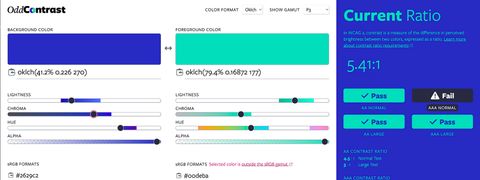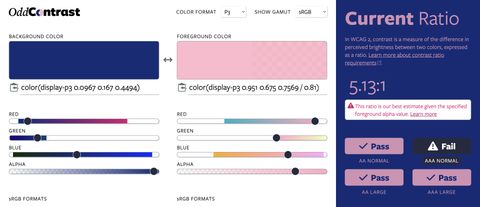Make the Web a More Colorful Place!
A guide to using new color spaces & formats with OddContrast
OddBird’s color tool not only checks contrast ratios, but supports the new CSS color formats and spaces.

Rethinking the CSS mixin proposal after CSS Day
The CSS Working Group has agreed to move forward with CSS-native mixins. But some recent mixin-like CSS tricks have an advantage that the official proposal doesn’t account for: they make it easy to remove a mixin after it’s already been mixed in.
@applyI’ve been thinking about CSS-native mixins. How do we create re-usable blocks of styling that can be ‘mixed in’ to various selectors, based on arbitrary conditions? I made a proposal last year, and it was adopted by the CSS Working Group for further exploration and specification. That proposal is similar to mixins in Sass and other pre-processors, and builds on CSS Nesting:
/* define it once */
@mixin --visually-hidden {
clip: rect(0 0 0 0);
clip-path: inset(50%);
height: 1px;
overflow: hidden;
position: absolute;
white-space: nowrap;
width: 1px;
}
/* use in various places */
[visually-hidden] {
@apply --visually-hidden;
}
[hidden-when=small] {
@container (inline-size < 20ch) {
@apply --visually-hidden;
}
}At parse time, the browser can (with some minor caveats) substitute each mixin call with a nested block of declarations:
[visually-hidden] {
& {
clip: rect(0 0 0 0);
clip-path: inset(50%);
/* … */
}
}
[hidden-when=small] {
@container (inline-size < 20ch) {
& {
clip: rect(0 0 0 0);
clip-path: inset(50%);
/* … */
}
}
}This is a straight-forward approach, that should be possible to implement. As authors we can build on that by including selectors and conditions inside the mixin code, or by passing in arguments. It’s a useful feature, but it has some limitations.
We don’t have CSS-native mixins yet, but we do have style queries (in Chromium, and Webkit beta) which can be used for mixin-like behavior:
/* define the mixin */
@container style(--fancy-em) {
em {
background: linear-gradient(
to bottom right,
var(--fancy-em)
);
color: white;
@supports (background-clip: text) or (-webkit-background-clip: text) {
-webkit-background-clip: text;
background-clip: text;
color: transparent;
font-weight: bold;
}
}
}
/* apply the mixin by giving --fancy-em a value */
p {
--fancy-em: mediumvioletred, teal;
}(You can see this style query demo working in a Chromium browser.)
While that may be useful once supported everywhere,
it has an even stronger ‘nesting’ requirement:
container queries cannot apply styles
to the container itself.
The example above works
because we query the parent paragraph
to apply styles on nested em elements.
Roman Komarov
has developed another mixin-like syntax
that works today in all major browsers,
using ‘cyclic toggles’
and revert-layer to create what he calls
Layered Toggles:
@layer defaults {
/* any defaults need to be defined in lower layers */
p { width: 80%; }
}
/* Define mixins in a higher layer */
@layer mixins {
*:not(:focus):not(:active) {
--hidden: var(--hidden--off);
--hidden--off: var(--hidden,);
--hidden--on: var(--hidden,);
clip:
var(--hidden--off, revert-layer)
var(--hidden--on, rect(0 0 0 0));
clip-path:
var(--hidden--off, revert-layer)
var(--hidden--on, inset(50%));
height:
var(--hidden--off, revert-layer)
var(--hidden--on, 1px);
/* etc… */
}
}
/* apply the mixin by overriding the custom property */
[hidden-when=small] {
@container (inline-size < 40ch) {
--hidden: var(--hidden--on);
}
}It’s not the most elegant solution, but it works – and can apply style changes directly, today, without any nesting.
‘The Cascade’ in CSS is an algorithm to resolve conflicts. Every property (including custom properties) on a given element can only have a single value. If the same property is declared twice, only one of those declarations will apply – the one with higher cascade priority (specificity, layers, source order, etc).
What stood out to me during Roman’s talk at CSS Day was the fact that both these pseudo-mixin solutions use custom properties to apply the mixin. As a result, the mixing-in declaration – the code that applies or doesn’t apply the mixin – cascades.
That leads to an interesting feature: a mixin can be applied in one place, and removed somewhere else. Once ‘turned off’, it’s as though the mixin was never applied at all. The properties simply revert to their un-mixed-in state:
See the Pen Un-mixing a mixin by @miriamsuzanne on CodePen.
We don’t get that same behavior
with the @apply rule as currently defined.
If we apply the same mixin twice
with different values,
both rules will be replaced by the internals of the mixin.
@mixin --card(--color) {
background: var(--color);
border: thick solid color-mix(in oklch, var(--color), black);
}
p { @apply --card(pink); }
p:last-child { @apply --card(powderblue); }The result after substitution will be:
p {
background: pink;
border: thick solid color-mix(in oklch, pink, black);
}
p:last-child {
background: powderblue;
border: thick solid color-mix(in oklch, powderblue, black);
}In some cases,
that will be fine.
The properties inside the mixin
will continue to cascade.
Each declaration of background overrides the previous,
and the same with border.
In the end, we get the expected result.
But we can’t ‘remove’ the mixin, or any of those property definitions, we can only override them with new values. That can be a real problem.
Let’s go back to our visually-hidden example.
We should really clarify that
we don’t want it applied when an element has focus.
With the custom property,
we can override a single property
wherever necessary:
[visually-hidden] {
--hidden: var(--hidden--on);
}
[hidden-when=small] {
@container (inline-size < 20ch) {
--hidden: var(--hidden--on);
}
}
:focus,
:active {
--hidden: var(--hidden--off);
}But with @apply we either have to
plan ahead for all conditions
before we apply the mixin:
[visually-hidden]:not(:focus):not(:active) {
@apply --visually-hidden;
}Or we need to carefully revert
every property of the mixin.
But… revert to what value?
Maybe we can use revert-layer
and some clever layering?
We could even build the off switch into our mixin:
/* when '--off' is undefined we get the output */
@mixin --visually-hidden(--off) {
clip: var(--off, rect(0 0 0 0));
clip-path: var(--off, inset(50%));
height: var(--off, 1px);
overflow: var(--off, hidden);
position: var(--off, absolute);
white-space: var(--off, nowrap);
width: var(--off, 1px);
}
@layer base {
[visually-hidden] {
@apply --visually-hidden;
}
}
/* put our overrides in a higher layer to revert from */
@layer overrides {
:focus,
:active {
/* set --off to revert-layer */
@apply --visually-hidden(revert-layer);
}
}That provides an off switch, but it requires some careful planning ahead, and the layering requirement seems fragile.
This isn’t a new or theoretical issue. After years of using Sass mixins, it’s something I’ve encountered many times. In most situations it’s possible to work around the issue, but sometimes it becomes quite complicated to get all the logic right in one place.
The cascade is useful for these situations. When we’re defining new CSS features we often ask should these behaviors cascade together, are they intertwined? If so, they belong in the same property.
It seems clear to me that it would be useful (at least sometimes) for the mixin-application syntax to cascade. But before we make any big changes we also need to ask:
@apply rules have similar issues?I don’t think we want something like
the JavaScript removeEventListener() function,
which requires a careful matching of arguments.
I’d like to avoid any @un-apply-style rules.
That has always seemed fragile to me,
and I’d rather use the cascade if we can.
What do you think? Should mixin calls cascade? Are there use cases for both behaviors?

A guide to using new color spaces & formats with OddContrast
OddBird’s color tool not only checks contrast ratios, but supports the new CSS color formats and spaces.

hint popovers, position-area and more
We have been busy updating the Popover and CSS Anchor Positioning Polyfills, but there is still more we can do with your help.

Display color gamut ranges and more
OddContrast, OddBird’s color format converter and contrast checker, gets new features – including the ability to swap background and foreground colors, and display color gamut ranges on the color sliders. Contrast ratios now incorporate foreground color alpha values.